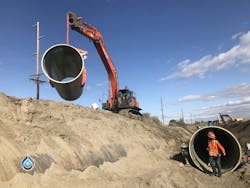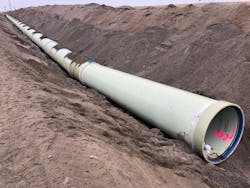Fiberglass Reinforced Pipe With Steel Fittings?
About the author:
Carl Pitzer, P.E., is business development manager for Thompson Pipe Group. Pitzer can be reached at [email protected].
A hybrid design of fiberglass reinforced pipe (FRP) with steel fittings saved an Oregon project owner more than $3 million. The design was created for the Columbia Improvement District (CID) which serves an agricultural community in the northeast part of the state. When CID engineers specified pipe options for a new pressure pipeline more than 7 miles long, they knew the inherent advantages of FRP would help them source a low-cost option for a new pipeline and increase water to local farms. The lightweight pipe is corrosion resistant, and offers low transportation, installation and operating costs. In addition, Thompson Pipe Group and CID engineers, and Oregon-based civil engineering firm Anderson Perry & Associates worked together to provide a solution that reduced an estimated project cost of more than $15 million to $11.8 million and accelerated installation time.
Since 2008 Thompson Pipe Group has designed FRP solutions, and for this project the engineering team presented a joint the team had never produced. FRP has multiple joint options, but through value engineering this project, the team determined steel fittings used in conjunction with FRP to be a highly effective option, would decrease the budget and accelerate installation time.
What is Fiberglass Reinforced Pipe (FRP)?
FRP is manufactured and installed all over the world. The material is manufactured with three basic raw materials: resin, fiberglass and silica sand. Fiberglass is used in space shuttles, bullet proof panels in armored vehicles, cars, hot tubs and waterslides. FRP also is used in a variety of water and sanitary sewer applications:
- Water transmission and distribution (potable and raw water);
- Sanitary sewerage collection systems and outfalls;
- Storm water;
- Hydroelectric penstock lines;
- Sea water intake and outfalls;
- Circulating cooling water, make-up and blow down lines for power plants;
- Industrial applications;
- Sliplining;
- Irrigation/agricultural;
- Desalination;
- Mining; and
- Cooling systems.
The FRP Thompson Pipe Group produces is manufactured with a continuous advancing mandrel process. Continuous glass fiber reinforcements are applied circumferentially. FRP offers several qualities beneficial to use in water and sewer applications.
The pipe is corrosion resistant and has a long service life without the need for linings, coatings or cathodic protection. Despite its light weight — which makes it easy to transport — it also maintains hydraulic characteristics consistently over its service life. It has a smooth bore and low friction as well, so pumping power does not need to be as great.
Finally, it is customizable in diameter to optimize flow volume and in length to adjust for flexibility in direct bury or casing lining installations. The lengths can be as long as 40 feet, which may also reduce the time spent joining the ends.
Groundwater Supply in Crisis
Locals in Boardman, Oregon, describe the reduction of groundwater availability as a crisis more than 60 years in the making. A stone’s throw from the Washington border in the Umatilla Basin, farmers grow potatoes, onions, watermelons and numerous other crops, but over the years the development of farmland and cities drove a decline in groundwater aquifers.
An existing pipeline was not large enough to utilize CID’s water rights so a new pipeline was developed to secure future population and agricultural growth. FRP was chosen for three reasons:
- Lightweight and long-lasting, the material offers low transportation and long-term operating costs.
- It is resistant to both inner and outer corrosion.
- Availability in a variety of standard pressure classes up to 450 psi depending on diameter, four different stiffness classes, and diameters ranging from 12 to 156 inches.
Despite the many benefits of FRP, this project presented three core challenges. First, there were numerous vertical and horizontal curves. Second, installation was to be conducted in the winter months. And third, there were concerns about long-term operating costs.
Numerous Vertical & Horizontal Curves
Thompson Pipe Group produced 39,000 linear feet of 72- and 75-inch of FRP for an operating pressure of 180-psi. Engineers designed the pipe to handle a surge from a dead-end condition with a water velocity of 7 feet per second.
Four types of joints are commonly used with FRP:
- Thrust blocks with the native soil support;
- A key-lock restrained joint that adds a nylon spline to the joint;
- Flanges bolted to the pipe that hold joints together; and
- Joint lamination similar to field welding steel pipes. For FRP, this means joints are laminated with layers of fiberglass.
In most sections a 3-degree gasketed coupling was sufficient to follow the valleys and troughs without fittings. For horizontal or vertical curves requiring more than 3 degrees deflection a thrust block or laminated joint is typically used, but Thompson Pipe Group engineers utilized welded steel fittings. The team developed a specially designed adaptor with tight tolerance to fit into the FRP coupling.
Additionally, the original design included 1,000 feet of steel carrier pipe under various crossings. During the design phase, Thompson Pipe Group value engineered the project to replace the majority of steel sections with FRP.
Installation During Winter
The installation contractor, Rotschy Inc., installed more than 1,500 linear feet per day during the winter. In this region temperatures drop below freezing, but the cold weather did not delay installation. Project Manager Hans Schmeusser said the process moved quickly.
“We used a pipe picker and an excavator push block to home the joints," he said. The average installation time for pipe of this size with all welded joints in these ground conditions would have been approximately 700 feet per day.
According to CID General Manager Mark Maynard, the project expanded capacity by more than 30 percent.
“Along with CID’s pump stations upgrades, the installation of the FRP 72- and 75-inch pipeline, which parallels the existing 72-inch steel water pipeline, maximum flows have increased from 140,000 gallons per minute to 190,000 gallons per minute with room to grow,” he said.
Transportation & Long-Term Operating Costs
To reduce shipping costs, the 72-inch pipe was nested inside the 75-inch sections. The pipe was manufactured by a TPG partner with a history of more than 30 million feet of FRP produced for more than 1,200 projects. Shipped from Istanbul, Turkey, the pipe arrived in the Port of Seattle and was delivered to the job site via train and truck.
With a life cycle more than a century long, FRP is low maintenance. The pipe is corrosion resistant and requires no cathodic protection. Additionally, for this project, the large pipe diameter leads to less head loss and pumping power.
Testing
After a rapid and successful installation, the pipe was tested and put into service securing the future of agriculture in northeast Oregon. The benefits flow beyond the water supply. “We can provide more farmers the water needed for their crops which adds to the region’s economic growth,” Maynard said. “CID pumped 95,000 acre feet of water in 2020. The smooth bore, low friction FRP performed very well in my opinion. I expect nothing less in the years to come.”


